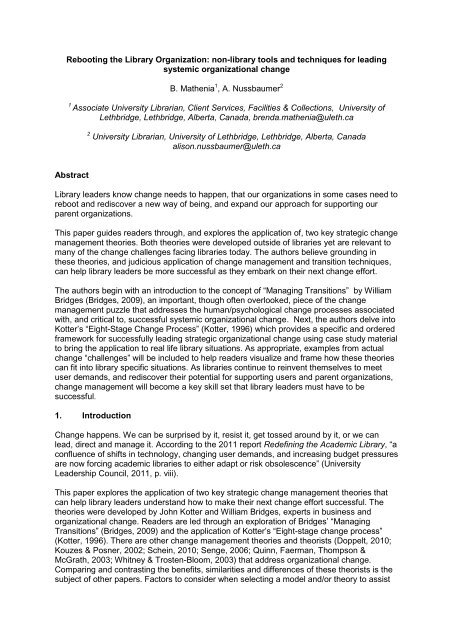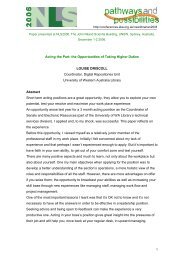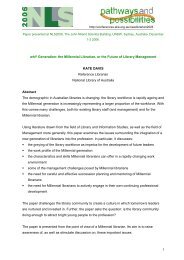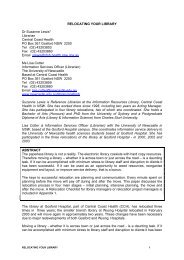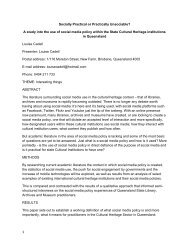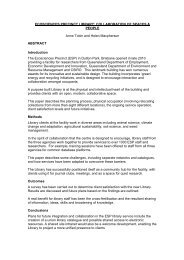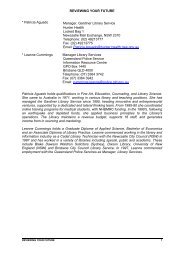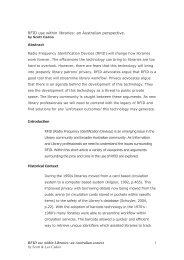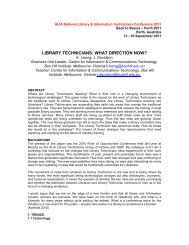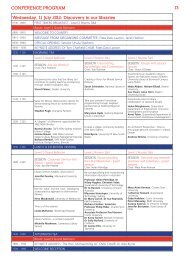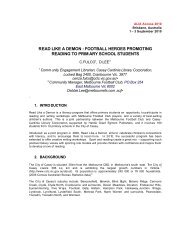Rebooting the Library Organization: non-library ... - ALIA conferences
Rebooting the Library Organization: non-library ... - ALIA conferences
Rebooting the Library Organization: non-library ... - ALIA conferences
Create successful ePaper yourself
Turn your PDF publications into a flip-book with our unique Google optimized e-Paper software.
<strong>Rebooting</strong> <strong>the</strong> <strong>Library</strong> <strong>Organization</strong>: <strong>non</strong>-<strong>library</strong> tools and techniques for leading<br />
systemic organizational change<br />
B. Ma<strong>the</strong>nia 1 , A. Nussbaumer 2<br />
1 Associate University Librarian, Client Services, Facilities & Collections, University of<br />
Lethbridge, Lethbridge, Alberta, Canada, brenda.ma<strong>the</strong>nia@uleth.ca<br />
Abstract<br />
2 University Librarian, University of Lethbridge, Lethbridge, Alberta, Canada<br />
alison.nussbaumer@uleth.ca<br />
<strong>Library</strong> leaders know change needs to happen, that our organizations in some cases need to<br />
reboot and rediscover a new way of being, and expand our approach for supporting our<br />
parent organizations.<br />
This paper guides readers through, and explores <strong>the</strong> application of, two key strategic change<br />
management <strong>the</strong>ories. Both <strong>the</strong>ories were developed outside of libraries yet are relevant to<br />
many of <strong>the</strong> change challenges facing libraries today. The authors believe grounding in<br />
<strong>the</strong>se <strong>the</strong>ories, and judicious application of change management and transition techniques,<br />
can help <strong>library</strong> leaders be more successful as <strong>the</strong>y embark on <strong>the</strong>ir next change effort.<br />
The authors begin with an introduction to <strong>the</strong> concept of “Managing Transitions” by William<br />
Bridges (Bridges, 2009), an important, though often overlooked, piece of <strong>the</strong> change<br />
management puzzle that addresses <strong>the</strong> human/psychological change processes associated<br />
with, and critical to, successful systemic organizational change. Next, <strong>the</strong> authors delve into<br />
Kotter‟s “Eight-Stage Change Process” (Kotter, 1996) which provides a specific and ordered<br />
framework for successfully leading strategic organizational change using case study material<br />
to bring <strong>the</strong> application to real life <strong>library</strong> situations. As appropriate, examples from actual<br />
change “challenges” will be included to help readers visualize and frame how <strong>the</strong>se <strong>the</strong>ories<br />
can fit into <strong>library</strong> specific situations. As libraries continue to reinvent <strong>the</strong>mselves to meet<br />
user demands, and rediscover <strong>the</strong>ir potential for supporting users and parent organizations,<br />
change management will become a key skill set that <strong>library</strong> leaders must have to be<br />
successful.<br />
1. Introduction<br />
Change happens. We can be surprised by it, resist it, get tossed around by it, or we can<br />
lead, direct and manage it. According to <strong>the</strong> 2011 report Redefining <strong>the</strong> Academic <strong>Library</strong>, “a<br />
confluence of shifts in technology, changing user demands, and increasing budget pressures<br />
are now forcing academic libraries to ei<strong>the</strong>r adapt or risk obsolescence” (University<br />
Leadership Council, 2011, p. viii).<br />
This paper explores <strong>the</strong> application of two key strategic change management <strong>the</strong>ories that<br />
can help <strong>library</strong> leaders understand how to make <strong>the</strong>ir next change effort successful. The<br />
<strong>the</strong>ories were developed by John Kotter and William Bridges, experts in business and<br />
organizational change. Readers are led through an exploration of Bridges‟ “Managing<br />
Transitions” (Bridges, 2009) and <strong>the</strong> application of Kotter‟s “Eight-stage change process”<br />
(Kotter, 1996). There are o<strong>the</strong>r change management <strong>the</strong>ories and <strong>the</strong>orists (Doppelt, 2010;<br />
Kouzes & Posner, 2002; Schein, 2010; Senge, 2006; Quinn, Faerman, Thompson &<br />
McGrath, 2003; Whitney & Trosten-Bloom, 2003) that address organizational change.<br />
Comparing and contrasting <strong>the</strong> benefits, similarities and differences of <strong>the</strong>se <strong>the</strong>orists is <strong>the</strong><br />
subject of o<strong>the</strong>r papers. Factors to consider when selecting a model and/or <strong>the</strong>ory to assist
leading change in your own organization include leader experience, organizational culture,<br />
scope of <strong>the</strong> change and staff change readiness. We selected Kotter and Bridges based on<br />
<strong>the</strong> previous experience and familiarity of <strong>the</strong> University Librarian in using <strong>the</strong>se models and<br />
in studying change <strong>the</strong>ory during completion of her MA Leadership degree.<br />
While <strong>the</strong> <strong>the</strong>ories of Kotter and Bridges have broad application, <strong>the</strong> examples that we use<br />
come from our own experience of leading systemic change in a medium sized Canadian<br />
university <strong>library</strong>. The process of leading considerable organizational, operational and<br />
cultural change began in 2008 and continues to <strong>the</strong> present (2012).<br />
Why change? Change, whe<strong>the</strong>r incremental or systemic, is a costly enterprise. As we will<br />
see through Bridges and Kotter, it involves letting go of current practice, accepted roles,<br />
traditions, patterns of communication and for some, a sense of self. It requires people to shift<br />
from what <strong>the</strong>y know into areas that are unfamiliar. It may be messy, <strong>non</strong>-linear, emotional,<br />
energizing, stressful, and rewarding. It takes commitment, “doggedness” and time. Staff<br />
must continue to reinvent <strong>the</strong>mselves to meet user demands and rediscover <strong>the</strong>ir potential<br />
for supporting users and parent organizations. Change management is a critical skill set that<br />
<strong>library</strong> leaders must have to ensure success.<br />
This paper is written from <strong>the</strong> leadership perspective. While staff input and feedback has<br />
been actively solicited on various aspects of specific changes initiated, we have not, at this<br />
point, solicited feedback on <strong>the</strong> overall change process.<br />
2. Context<br />
The University of Lethbridge, founded in 1967, is a medium size comprehensive university<br />
with an enrollment of approximately 8,400 students and 1,188 employees. Between 1967<br />
and 2008, <strong>the</strong> <strong>Library</strong> had ten different University Librarians; a high turnover rate at <strong>the</strong> top<br />
most level within <strong>the</strong> <strong>Library</strong>. In o<strong>the</strong>r areas, including staff and professional librarians, <strong>the</strong>re<br />
is a very low rate of turnover. Professional librarians (11 in total) are tenured faculty,<br />
governed by a faculty association and handbook and have been employed at <strong>the</strong> University<br />
an average of 14 years. Staff (24 full & part time), are unionized and average 19 years of<br />
service to <strong>the</strong> University. Throughout this paper, unless o<strong>the</strong>rwise specified, <strong>the</strong> word “staff”<br />
or phrase “<strong>library</strong> staff” refers to anyone working within <strong>the</strong> <strong>library</strong> including union and <strong>non</strong>union<br />
staff, faculty and administration. In addition, <strong>the</strong> use of “I” refers to <strong>the</strong> University<br />
Librarian (UL) in <strong>the</strong> first year of her term (2008). The use of “we” refers to <strong>the</strong> UL and <strong>the</strong><br />
two Associate University Librarians (AULs) who since 2009 form <strong>the</strong> senior <strong>library</strong> leadership<br />
team.<br />
Using a multi-faceted process - review of key internal documents, discussions with <strong>library</strong><br />
staff, conversations with senior administration and knowledge and experience from working<br />
in o<strong>the</strong>r academic libraries - it became clear to <strong>the</strong> University Librarian that <strong>the</strong> <strong>library</strong> was<br />
“stuck” (Nussbaumer & Merkley, 2010, p. 678). The <strong>library</strong>‟s operations, organizational<br />
structure and aspects of organizational culture were layered with self-made barriers that<br />
limited <strong>the</strong> <strong>library</strong> staffs ability to be responsive to user needs and transform into a 21 st<br />
century academic <strong>library</strong>.<br />
Operationally <strong>the</strong>re was a staffing model based on <strong>the</strong> concept “everyone does <strong>the</strong> same<br />
thing”, discouraging workforce differentiation. (Huselid, Beatty, & Becker, 2005). The benefit<br />
for unionized staff was a high degree of cross-training. However, <strong>the</strong> overall outcome was an<br />
organizational culture that discouraged flexibility, innovation, expertise and risk. The<br />
organizational structure had flattened to <strong>the</strong> degree that no one was responsible or<br />
accountable. Service was a “bad word”. Power was held by a few highly influential<br />
individuals who were deeply vested in <strong>the</strong> status quo. (Nussbaumer & Merkley, 2010, p.<br />
679).
Many of <strong>the</strong> initial challenges, individual and collective negative responses to change, and<br />
tough measures implemented by <strong>the</strong> <strong>library</strong> leadership team in years one and two, were<br />
presented in detail in a previous paper, “The path of transformational change” (Nussbaumer<br />
& Merkley, 2010). This paper does not reiterate those experiences, focusing more on <strong>the</strong><br />
positive changes and results that we are realizing in our third and fourth year of<br />
transformational change.<br />
What follows is not a recipe for change. It is an example of how we were able to learn, apply<br />
and benefit from <strong>the</strong> work of change management <strong>the</strong>orists Kotter and Bridges in our<br />
organization. It demonstrates how you can use <strong>the</strong>se tools to effect change in your own<br />
<strong>library</strong>.<br />
3. Managing Transition for Successful Change<br />
According to <strong>the</strong> Oxford English Dictionary Online (2012), transition is defined as “a passing<br />
or passage from one condition, action, or (rarely) place, to ano<strong>the</strong>r; change”. Change is<br />
defined as “<strong>the</strong> act or fact of changing; substitution of one thing for ano<strong>the</strong>r” (Oxford English<br />
Dictionary, 2012).<br />
William Bridges (2009) provides a guiding framework for managing transition; <strong>the</strong> human<br />
perception of change that works in tandem with o<strong>the</strong>r change <strong>the</strong>ories such as Kotter‟s.<br />
According to William Bridges‟ (2009), leaders may not fully grasp <strong>the</strong> difference between<br />
change and transition and why it is so important to manage transition.<br />
Bridges (2009) tells us that change is situational; it‟s what happens, whereas transition is<br />
psychological. “It is a three-phase process that people go through as <strong>the</strong>y internalize and<br />
come to terms with <strong>the</strong> details of <strong>the</strong> new situation that <strong>the</strong> change brings about” (p. 3).<br />
When most people refer to change, <strong>the</strong>y are talking about an event that happens - you move<br />
to a new house, a colleague retires, or <strong>the</strong> <strong>library</strong> outsources <strong>the</strong> processing of books.<br />
Transition on <strong>the</strong> o<strong>the</strong>r hand is how people experience <strong>the</strong> event or <strong>the</strong> change. As <strong>the</strong><br />
<strong>library</strong> begins to outsource <strong>the</strong> processing of books, those individuals involved in that<br />
activity, ei<strong>the</strong>r directly or indirectly, will experience <strong>the</strong> change on a psychological and often<br />
very personal level. This is one reason <strong>library</strong> leaders sometimes witness strong, seemingly<br />
illogical, responses from staff when change is introduced. These responses can include fear,<br />
anger, disinterest, disengagement, anxiety and loss of identity. The transition process is an<br />
emotional, scary and deeply personal experience for each individual involved in <strong>the</strong> change.<br />
“Transitional environments are rife with questions, uncertainty and fear of <strong>the</strong> unknown.<br />
What will happen next? How will I fit in” (Dewey, 2012, p. 136)? To ensure success, change<br />
leaders must try to manage <strong>the</strong> transition process from start to finish. Leaders must be<br />
prepared for <strong>the</strong> fact that no two people will transition in <strong>the</strong> same way and <strong>the</strong>re may be<br />
individuals who will never fully transition and for whom <strong>the</strong> change will remain a feared or<br />
dreaded outcome.<br />
Bridges (2009) outlines a three-phase process that begins with ending, moves people into<br />
what he calls <strong>the</strong> “neutral zone” and ends with a new beginning. Managing transition is quite<br />
simply a process to help people through <strong>the</strong>se three phases (p. 4). Because transition is a<br />
process by which people unplug from an old world and plug into a new world, we can say<br />
that transition starts with an ending and finishes with a beginning (Bridges, 2009, p. 4-5).<br />
Phase 1: Letting go of <strong>the</strong> old ways and <strong>the</strong> old identity people had.<br />
This first phase involves ending old ways and is a critical time to help people deal with <strong>the</strong>ir<br />
losses. During this phase <strong>library</strong> staff will be asked to stop doing something – usually in<br />
preparation for implementing something new. It is important during this phase to clearly
acknowledge what is ending, and help staff consider what it is that is being lost. It might be<br />
helpful as well to find out just how happy <strong>the</strong>y were with <strong>the</strong> status quo. Leaders need to<br />
consider carefully how to get employees to embrace <strong>the</strong> change, to eliminate, or manage,<br />
<strong>the</strong>ir fear and how best to help <strong>the</strong>m develop a new identity and renewed sense of purpose<br />
associated with <strong>the</strong> change (Bridges, 2009, p. 23).<br />
Phase 2: The Neutral Zone.<br />
The neutral zone is an in-between time when <strong>the</strong> old is gone but <strong>the</strong> new isn‟t fully<br />
operational. It is a sort of limbo when critical psychological realignments and repatternings<br />
take place. It is during this time that individual and group anxiety will rise, motivation will<br />
decrease, staff may become resentful of <strong>the</strong> changes being “thrust upon <strong>the</strong>m” and may<br />
increase <strong>the</strong>ir defensiveness and try to protect <strong>the</strong>ir “position in <strong>the</strong> organization” ever more<br />
forcefully. The neutral zone is intentionally ambiguous. There needs to be time for old ways<br />
to fade before new ways can take hold (Bridges, 2009, p. 39).<br />
The neutral zone is <strong>the</strong> longest of <strong>the</strong> three phases and <strong>the</strong> most varied. When staff are in<br />
<strong>the</strong> neutral zone, confusion reigns, individuals feel overloaded and important tasks likely go<br />
undone. This is a time when some turnover of staff may happen. Some individuals will<br />
prosper as <strong>the</strong>y find that with old ways gone, and no new path set, <strong>the</strong>y can use <strong>the</strong>ir<br />
creativity to reassess or re-establish <strong>the</strong>ir role within <strong>the</strong> organization. O<strong>the</strong>rs will have a<br />
more difficult time, and leaders may be inclined to push <strong>the</strong>m through quickly or<br />
accommodate <strong>the</strong>m in different ways. It is important that each individual spends whatever<br />
time is necessary and natural for <strong>the</strong>m in <strong>the</strong> neutral zone. Without a natural progression<br />
through <strong>the</strong> transition, old habits will come back and true transition will not occur. The neutral<br />
zone is also an appropriate time to provide training that reinforces <strong>the</strong> new goals of <strong>the</strong><br />
organization. Set short term goals and take advantage of opportunities such as pilot projects<br />
to try new things and achieve small successes (Bridges, 2009, p. 39).<br />
Phase 3: The New Beginning.<br />
The new beginning is when staff come out of transition (<strong>the</strong> neutral zone) and develop <strong>the</strong>ir<br />
new identity, experience new energy, and discover a new sense of purpose for <strong>the</strong>mselves<br />
and <strong>the</strong>ir organization. This is when <strong>the</strong> changes begin to work. Change will root when new<br />
beginnings are in place (Bridges, 2009, p. 57).<br />
Bridges‟ focus on <strong>the</strong> impact of change on people weaves its way throughout Kotter‟s stages<br />
for leading change.<br />
4. Strategies for Systemic Change<br />
Kotter identifies 8 key errors that are frequently made when leading change and he provides<br />
an 8 stage process to circumvent <strong>the</strong>se errors. Table I shows <strong>the</strong> errors and <strong>the</strong> related<br />
stages for leading change.
Table I<br />
Summary of Kotter’s 8 Key Errors and 8 Key Stages for leading change<br />
Errors Stages<br />
Allowing too much complacency<br />
Failure to create a guiding coalition<br />
Underestimating <strong>the</strong> power of vision<br />
Under communicating <strong>the</strong> vision<br />
Permitting obstacles to block <strong>the</strong> new vision<br />
Failing to create short term wins<br />
Declaring victory too soon<br />
Neglecting to anchor changes firmly in <strong>the</strong><br />
corporate culture<br />
Source: Kotter, J. Leading Change. (1996, pp. 1-21).<br />
Establishing a sense of urgency<br />
Creating a guiding coalition<br />
Developing a vision and strategy<br />
Communicating <strong>the</strong> change vision<br />
Empowering broad based action<br />
Generating short term wins<br />
Consolidating gains and producing more<br />
change<br />
Anchoring changes in <strong>the</strong> culture<br />
Kotter (1996) is clear that for successful change to occur his eight-stage model for change<br />
must proceed in <strong>the</strong> order given (p.23). He warns that if you race through steps or skip <strong>the</strong>m<br />
entirely, “…you rarely establish a solid enough base on which to proceed….and without step<br />
eight you never get to <strong>the</strong> finish line and make <strong>the</strong> changes stick” (Kotter, 1996, p. 23).<br />
4.1 Establish a sense of urgency<br />
The first error Kotter (1996) identifies is allowing too much complacency (p. 4). He asserts<br />
that leaders, “… underestimate how hard it is to drive people out of <strong>the</strong>ir comfort zones” (p.<br />
5). Wheatley (1999) states that, “Change is prompted only when an organism decides that<br />
changing is <strong>the</strong> only way to maintain itself” (p. 20). Essentially individuals resist change<br />
unless <strong>the</strong> consequences of not changing are more compelling than living with <strong>the</strong> status<br />
quo. Therefore, if leaders want to initiate change, <strong>the</strong>y must establish a sense of urgency<br />
(Kotter, 1996, p. 21).<br />
In 2008 when I (University Librarian) first identified <strong>the</strong> need for systemic change in <strong>the</strong><br />
<strong>library</strong>, I was <strong>the</strong> only one who felt a sense of urgency. I employed several strategies to<br />
create a broader sense of urgency amongst <strong>library</strong> staff. I decommissioned all current<br />
internal operational and organizational committees. This was done to open <strong>the</strong> door for new<br />
ways of thinking, communicating and interacting. The immediate impact was as varied as <strong>the</strong><br />
individuals affected by this change. It included a shift in <strong>the</strong> balance of power, a sense of<br />
destabilization, a sense of loss, a fear of <strong>the</strong> unknown, a hope for <strong>the</strong> future, and an<br />
uncertainty about how things would get done. The loss of a familiar structure created a<br />
sense of urgency.<br />
The responses we witnessed by staff to <strong>the</strong> changes - <strong>the</strong> feelings of destabilization, sense<br />
of loss, fear of <strong>the</strong> unknown and general uncertainty - are earmarks of Bridges (2009) neutral<br />
zone. The ending of <strong>the</strong> old committee structures (phase 1), was a disruption of “<strong>the</strong> way we<br />
do things around here” and acted to push everyone into <strong>the</strong> neutral zone (phase 2). This<br />
critical step of ending <strong>the</strong> old without immediately replacing it with something else is<br />
necessary if new ways of thinking and being are to be formed. It was nearly a year before<br />
any new groups were created to once again provide familiar, though not <strong>the</strong> same, structure<br />
related to certain <strong>library</strong> efforts. A year in <strong>the</strong> neutral zone creates a lot of anxiety and fear<br />
on <strong>the</strong> part of staff. It also serves to create a desire for structure, for a little bit of what is<br />
familiar (i.e. groups to do work) and it allows for <strong>the</strong> creation of a new framework for a new<br />
<strong>library</strong> organization. By creating what could be considered a void in our processes and<br />
structure, and by being patient, we were able to fill that void with more functional and<br />
appropriate groups/structure that our organization would need to move ahead toward lasting<br />
organizational and cultural change.
I introduced new language into our daily discourse. I spoke of “moving forward” and created<br />
three guiding questions to provide us with a framework for change. The intent was to provide<br />
a new structure using language. The three guiding questions were:<br />
If we built it today what would it look like?<br />
How are we supporting <strong>the</strong> University‟s Strategic Plan?<br />
How are we adding value to our students, faculty and staff?<br />
The use of new phrases, open-ended questions and a focus on <strong>the</strong> future contributed to a<br />
sense of urgency.<br />
Bridges (2009) suggests that <strong>the</strong> neutral zone provides “time to step back and take stock, a<br />
time to question <strong>the</strong> “usual,” and a time to come up with new and creative solutions to <strong>the</strong><br />
organization‟s difficulties” (p. 50). The new language of “moving forward” was introduced and<br />
designed to provide staff with a new way of thinking. The three questions provided a means<br />
for evaluating <strong>the</strong> role of <strong>the</strong> <strong>library</strong> and <strong>the</strong> roles that individuals play within <strong>the</strong> <strong>library</strong>. The<br />
new phrases, used often, were simple and easy to grasp. The simplicity of it made it easy for<br />
some staff to get on board with it quickly and that in turn helped <strong>the</strong>m move through <strong>the</strong><br />
neutral zone faster.<br />
Finally, I hired an external consulting firm to work with us to review all of our operations for<br />
materials, from selection to access. The consultants interviewed all staff, reviewed a myriad<br />
of internal documentation and reports, and <strong>the</strong>n made recommendations on how we could<br />
move forward, based on best practices. Their final report, “Workflow Analysis: Selection-to-<br />
Access” and presentation to all <strong>library</strong> staff was critical in creating a sense of urgency. The<br />
report clearly indicated how antiquated we were technologically, operationally and<br />
organizationally vis-a-vis best practices in academic libraries. The report was used as a<br />
blue-print for change.<br />
Laying <strong>the</strong> foundation to create a sense of urgency took one year. Two new AULs arrived in<br />
2009 at <strong>the</strong> beginning of <strong>the</strong> second year of <strong>the</strong> change process. Ensuring <strong>the</strong><br />
implementation of <strong>the</strong> recommendations in <strong>the</strong> “Workflow Analysis” report became <strong>the</strong> first<br />
assignment of one of <strong>the</strong> new AULs.<br />
4.2 Create a guiding coalition<br />
A guiding coalition is a group of people who are like-minded about <strong>the</strong> changes that need to<br />
occur. They can come from anywhere within <strong>the</strong> organization. The group must include a<br />
balance between individuals with positional power, expertise, credibility and leadership<br />
(Kotter, p. 57).<br />
Just as I felt during my first year that I was <strong>the</strong> only one with Kotter‟s sense of urgency, I was<br />
also <strong>the</strong> initial guiding coalition. The coalition consisted of “me, myself and I”. While on <strong>the</strong><br />
surface this is humorous, it is not sustainable. Much can be accomplished by charismatic<br />
leaders and strong individuals, but sheer force of personality will only take change so far<br />
(Conger & Kanungo, 1987). A guiding coalition is necessary to move members of an<br />
organization beyond structural change to behavioral change (Kotter, 1997, p. 6).<br />
When <strong>the</strong> new AULs arrived, <strong>the</strong> guiding coalition increased from one to three. As <strong>the</strong><br />
recommendations in <strong>the</strong> consultants report were implemented, new teams were created,<br />
staff from different departments began to work toge<strong>the</strong>r and new reporting structures were<br />
designed. Implementation ended <strong>the</strong> old ways and laid a path to new ways of working and<br />
new beginnings. During <strong>the</strong> implementation, <strong>the</strong> staff were hip deep in <strong>the</strong> neutral zone as<br />
many unknowns remained and much „finding our way‟ was taking place. This was a time of
“reorientation and redefinition” (Bridges, 2009, p.43) for <strong>library</strong> staff. Workflow improvements<br />
helped reallocate what work would be completed by staff allowing a greater focus in areas<br />
such as support for electronic access to resources and digitization efforts that supported our<br />
“moving forward” initiatives. These organizational changes facilitated <strong>the</strong> expansion of <strong>the</strong><br />
guiding coalition, extending beyond <strong>the</strong> senior <strong>library</strong> leadership team to include staff from<br />
across <strong>the</strong> <strong>library</strong>.<br />
From our experience <strong>the</strong>re are several key benefits that derive from a guiding coalition. First,<br />
<strong>the</strong>re is a tremendous positive impact on leadership morale. It can be stressful, fatiguing and<br />
discouraging to be <strong>the</strong> sole voice for change. As o<strong>the</strong>rs come on board, it is affirming,<br />
encouraging and provides energy to <strong>the</strong> leadership team. Second, from time to time leaders<br />
can feel like giving up. The benefit of a guiding coalition is that when one is discouraged<br />
o<strong>the</strong>rs are <strong>the</strong>re to keep focused on <strong>the</strong> vision. Finally, <strong>the</strong> ability to delegate and extend<br />
informal channels of communication and influence is streng<strong>the</strong>ned.<br />
We did not officially identify members of a guiding coalition. What we did is nurture, reward<br />
and acknowledge staff who decided to work with us towards positive transformational<br />
change. This occurred formally and informally ranging from position reclassifications,<br />
significant opportunities for training and development, and opportunities to create and work<br />
in new teams. With “coalition creep” <strong>the</strong> circle of positive engagement increases.<br />
4.3 Developing a vision and strategy<br />
It is impossible to lead change without a vision. Your vision is your purpose, it is where you<br />
want to get to, it is your picture of <strong>the</strong> future (Kotter, 1996, p. 68). Vision helps you focus<br />
your energy and align your resources to obtain clear goals and it helps you to say “no” to<br />
opportunities that do not move you forward.<br />
Creating a “vision statement” can be a unifying or a divisive exercise. In our <strong>library</strong> <strong>the</strong> end<br />
result of previous “visioning” exercises was divisiveness between staff. Knowing this coming<br />
into <strong>the</strong> position, I did not engage in a visioning exercise. I simply declared that <strong>the</strong> vision for<br />
<strong>library</strong> staff was to support <strong>the</strong> University‟s 2009-2013 Strategic Plan. Our strategy to attain<br />
<strong>the</strong> vision is encapsulated in <strong>the</strong> statement “moving forward” and given structure by <strong>the</strong> three<br />
guiding questions articulated earlier.<br />
A lack of consultation regarding <strong>the</strong> creation of a vision statement went against generally<br />
accepted practice in <strong>the</strong> academic context and much of <strong>the</strong> business literature (Senge,<br />
2006). However, I made this choice as a conscious strategic decision to move us forward<br />
from a previous unproductive and harmful experience. While we have not yet arrived at <strong>the</strong><br />
point where a visioning exercise would build unity and cohesiveness, it is something to be<br />
considered by <strong>the</strong> leadership team in <strong>the</strong> longer term.<br />
4.4 Communicating <strong>the</strong> change vision<br />
Kotter (1996) notes that one of <strong>the</strong> key errors committed during change is under<br />
communication (p. 9). This extends well beyond <strong>the</strong> change vision. You truly can never<br />
communicate too much. When you are part of <strong>the</strong> leadership team, you understand why you<br />
are doing things <strong>the</strong> way you are, you have <strong>the</strong> end-goal constantly in sight and you have a<br />
high degree of control over <strong>the</strong> process. Your staff do not. Change leaders typically go<br />
through <strong>the</strong>ir transitions before <strong>the</strong>y launch such changes, and have long since put <strong>the</strong>ir<br />
“endings” and “neutral zone” experiences behind <strong>the</strong>m and are ready for a “new beginning”<br />
(Bridges, 2009, p. 65). As leaders, we often think that we have stated, restated, shared,<br />
communicated, proclaimed, sought input, given feedback and so on to <strong>the</strong> point of overkill<br />
and <strong>the</strong>n we encounter someone who doesn`t know, hasn`t heard, or is unfamiliar with<br />
current efforts.
We continue to try a variety of ways to communicate. We endeavor to share, seek input, and<br />
listen. We use: <strong>library</strong> intranet site, email, staff listserv, staff meetings of <strong>the</strong> whole, meetings<br />
of different teams, open-door approach, and methods for a<strong>non</strong>ymous input and questions.<br />
The forms and methods of communication are not viewed as adequate by everyone.<br />
<strong>Organization</strong>al culture often has a huge impact on how and whe<strong>the</strong>r communication is<br />
viewed to have occurred and is accepted.<br />
4.5 Empowering broad-based action<br />
There tend to be many self-imposed barriers within our libraries. While not initially designed<br />
to be barriers, many of our policies and procedures, organizational structures, handbooks<br />
and collective agreements can be rife with barriers to change. Our own organizational<br />
culture, attitudes and influence of individuals, and formal and informal mechanisms of<br />
workplace reward and punishment can create significant barriers to change. These barriers<br />
need to be identified, acknowledged and many of <strong>the</strong>m removed in order to empower broadbased<br />
action (Kotter, 1996). Some areas may be beyond <strong>the</strong> <strong>library</strong> leadership‟s purview, at<br />
least in <strong>the</strong> short to medium term, such as handbooks and collective agreements. What is<br />
important is to remove <strong>the</strong> barriers that you do have control over.<br />
The most useful strategy for us to address barriers was our guiding question, “If we built it<br />
today what would it look like?” This allowed us to look with fresh eyes and to imagine starting<br />
from scratch without having to “jerry-rig” existing policies, operational procedures and<br />
organizational structures. For example, although used as a stratagem under Kotter‟s stage<br />
one, creating a sense of urgency, <strong>the</strong> removal of our existing committee structure overcame<br />
a huge operational barrier and began to influence a significant cultural barrier. We had many<br />
old policies that were not customer-friendly which we decided to disregard. We did not rewrite<br />
or formally remove <strong>the</strong>se policies which caused some consternation amongst staff that<br />
were trained to “follow <strong>the</strong> policy”. This was a conscious commitment by <strong>the</strong> leadership team<br />
to ensure our staff would traverse <strong>the</strong> neutral zone fully.<br />
Our new approach became “find ways to say yes”. Under <strong>the</strong> auspices of our Client Services<br />
AUL, staff are empowered to make customer service centred decisions. A commitment to,<br />
and high investment in, staff training was critical to empowering action, as is having a strong<br />
trust relationship between staff and supervisor (AUL). Staff must feel confident and<br />
supported. Training is essential in preparing staff to be knowledgeable in new roles and able<br />
to perform new responsibilities. Various training approaches continue to be used including<br />
online, individual, group, on campus, off campus, <strong>conferences</strong>, and work toward specialized<br />
certificates.<br />
The most challenging barriers are those which are embedded in <strong>the</strong> organizational culture.<br />
An organizational culture reflects core shared beliefs, even if not everyone is happy or<br />
satisfied with those beliefs. These workplace norms, values and beliefs are often under<br />
threat during times of significant change. The threat is revealed through staff resistance, fear<br />
and hostility. This response cannot be ignored as it will surface and resurface throughout <strong>the</strong><br />
change process. It is here that Bridge‟s work with <strong>the</strong> human side of change and transition<br />
comes to bear.<br />
4.6 Generating short-term wins<br />
Transformational change takes time. We are in our fourth year of <strong>the</strong> systemic change<br />
process. People need meaningful feedback, acknowledgement and an opportunity to<br />
celebrate key milestones along <strong>the</strong> way. Kotter (1996) calls this process „creating short-term<br />
wins‟ (p. 11). Bridges (2009) suggests we “set short-range goals for people to aim toward. . .<br />
give people a sense of achievement and of movement . . . to help counter <strong>the</strong> feelings of
eing lost that are common. . . in <strong>the</strong> neutral zone” (p. 46). Failure to acknowledge key<br />
events can lead to discouraged staff and contribute to a feeling that nothing is getting done<br />
or ever going to change. There is a risk that individuals who are metaphorically “sitting on<br />
<strong>the</strong> fence” could become detractors ra<strong>the</strong>r than supporters of <strong>the</strong> vision.<br />
Once again, organizational culture has tremendous influence on how short-term wins will be<br />
celebrated. <strong>Organization</strong>s that are quick to celebrate each o<strong>the</strong>rs‟ successes will have fun<br />
with this. <strong>Organization</strong>s where this culture does not exist may be caught between <strong>the</strong> need<br />
to acknowledge <strong>the</strong> short-term wins and <strong>the</strong> fear of drawing attention to specific people or<br />
teams or groups. Lack of comfort with public celebration continues to be part of our culture.<br />
Those of us who have experienced celebratory cultures have to modify our expectations and<br />
move slowly into this area.<br />
It is important for <strong>the</strong> leadership team to celebrate short-term wins. We catch ourselves<br />
focussing on <strong>the</strong> future and what else must be done ra<strong>the</strong>r than spending time in <strong>the</strong> present<br />
and celebrating recent accomplishments. It is very important for leaders to stop and<br />
celebrate. Celebration re-energizes, encourages and lets o<strong>the</strong>rs know what one is proud of.<br />
One of <strong>the</strong> ways that we celebrate as a leadership team is by speaking at <strong>conferences</strong><br />
allowing us to reflect on all of <strong>the</strong> positive gains while living through <strong>the</strong> challenges.<br />
4.7 Consolidating gains and producing more change<br />
Kotter warns against celebrating victory too soon. He states that, “until changes sink down<br />
deeply into culture, which for an entire company can take three to ten years, new<br />
approaches are fragile and subject to regression” (Kotter, 1996, p. 13). The key to success is<br />
to generate more change, not less; develop your people and hire more; delegate projects to<br />
<strong>the</strong> lowest level where <strong>the</strong>re will be success; reduce unnecessary interdependencies and<br />
have senior leadership continue to maintain clarity of shared purpose and a sense of<br />
urgency (Kotter, 1996, p. 143).<br />
We are at this stage within our <strong>library</strong>. Our changes remain very close to <strong>the</strong> surface and are<br />
not embedded into our culture. While many endings have occurred, and a few new<br />
beginnings have taken place, our staff remains awash in <strong>the</strong> neutral zone. The reason <strong>the</strong>y<br />
remain in <strong>the</strong> neutral zone is that “<strong>the</strong> outlook, attitudes, values, self-images, and ways of<br />
thinking that were functional in <strong>the</strong> past have to “die” before people can be ready for life in<br />
<strong>the</strong> present” (Bridges, 2009, p. 43). That has not yet happened in our organization.<br />
We have had some success in building on change. Changes implemented in our technical<br />
service areas, which we knew would be successful, helped to build a level of trust and selfesteem/value<br />
boost that allowed us to leverage additional change. Specifically, individuals<br />
involved in <strong>the</strong> technical services changes also work at <strong>the</strong> <strong>library</strong>‟s circulation services desk.<br />
The back of house changes created a recharge effect that opened <strong>the</strong> minds of staff to <strong>the</strong><br />
possibility of change, that it could really happen and be successful, and <strong>the</strong>y were a part of<br />
that success. This encouraged fur<strong>the</strong>r “risk taking”, built desperately needed self esteem and<br />
confidence among staff and established a trust relationship with <strong>the</strong> <strong>library</strong> leadership team<br />
(Nussbaumer, Merkley, & Ma<strong>the</strong>nia, 2012, p. 313).<br />
4.8 Anchoring new approaches in <strong>the</strong> culture<br />
This is <strong>the</strong> concluding stage of Kotter`s eight stage process for change. Kotter (1996) states<br />
that, “<strong>the</strong> biggest impediment to change in a group is culture” (p. 155). You will know when<br />
<strong>the</strong> culture has shifted when what is now feared, questioned, and distrusted becomes,<br />
“that`s how we do things here”. And you will continue to change.
New beginnings “happen when <strong>the</strong> timing of <strong>the</strong> transition process allows <strong>the</strong>m to happen”<br />
which is why it is so important to understand <strong>the</strong> transition process and where your people<br />
are in it (Bridges, 2009, p. 59). Changes only happen once staff have reached <strong>the</strong>ir new<br />
beginning.<br />
5. Conclusion<br />
While we believe that Kotter has an excellent model, it is incredibly important to pay attention<br />
to staff as people, not just employees. It is here that <strong>the</strong> work of William Bridges contributes<br />
to our understanding of <strong>the</strong> impact of change on people as opposed to process.<br />
Bridges (2009) provides a useful framework that can help leaders manage <strong>the</strong> transitions<br />
people need to go through for change to happen and be truly lasting. Transition takes time,<br />
patience and a capacity for <strong>the</strong> unknown by both leaders and those <strong>the</strong>y lead. Long term<br />
successful change can only happen when <strong>the</strong> change, <strong>the</strong> “new” way, becomes “our way”.<br />
Kotter‟s (1996) eight stages can provide leaders with a model for moving organizational and<br />
transformational change forward to success. Our experience is that while all of <strong>the</strong> stages<br />
may be critical, <strong>the</strong> process is not sequential nor is it linear.<br />
Finally, our experiences show that Bridges‟ framework for helping people manage transitions<br />
should be incorporated as early as possible in <strong>the</strong> change process in order to realize <strong>the</strong><br />
greatest benefit to <strong>the</strong> organization and <strong>the</strong> individuals. Additionally, we learned through our<br />
unique experiences that <strong>the</strong>ories such as Kotter‟s are written for, and about, organizations<br />
that need to change but are o<strong>the</strong>rwise healthy or only slightly unhealthy. It is important to<br />
realize that <strong>the</strong>se and o<strong>the</strong>r <strong>the</strong>ories may only be moderately effective in a toxic or severely<br />
unhealthy organization. An examination of <strong>the</strong> application of change <strong>the</strong>ories in a toxic<br />
organizational culture is <strong>the</strong> subject of a future paper.
References<br />
Bridges, W. (2009). Managing transitions: Making <strong>the</strong> most of change (3 rd ed.). Philadelphia,<br />
PA: De Capo Press.<br />
Change. (n.d.). In Oxford English Dictionary online. (March 2012). Oxford University Press.<br />
Retrieved March 16, 2012, from http://0-www.oed.com.darius.uleth.ca/.<br />
Conger, J. A., & Kanungo, R. N. (1987). Toward a behavioral <strong>the</strong>ory of charismatic<br />
leadership in organizational settings. The Academy of Management Review, 12, 637-<br />
647.<br />
Dewey, B. I. (2012). In Transition: The special nature of leadership change. Journal of<br />
<strong>Library</strong> Administration, 52, 133-144. doi:10.1080/01930826.2012.629965<br />
Doppelt, B. (2010). Leading change toward sustainability: A change management guide for<br />
business, government and civil society (2 nd revised ed.). Sheffield, UK: Greenleaf<br />
Publishing.<br />
Huselid, M. A., Beatty, R. W. and Becker, B. E. (2005), “Players or positions: <strong>the</strong> strategic<br />
logic of workforce management”, Harvard Business Review, 83(12), 110-117.<br />
Kotter, J. P. (1996). Leading change. Boston, MA: Harvard Business School Press.<br />
Kouzes, J. M., & Posner, B. Z. (2002). The leadership challenge (3 rd ed.). San Francisco,<br />
CA: John Wiley & Sons.<br />
Nussbaumer, A., & Merkley, W. (2010). The path of transformational change. <strong>Library</strong><br />
Management, 31, 678-689.<br />
Nussbaumer, A., Merkley, W., & Ma<strong>the</strong>nia, B. (2012). Getting to go: Strategic use of external<br />
expertise in leveraging change. In Strauch, K. P., Bernhardt, B. R., & Hinds, L.A.<br />
(Eds.), Charleston Conference Proceedings, 2010: Anything goes (pp. 307-316).<br />
West Lafayette, IN: Purdue University Press. Awaiting publication.<br />
Quinn, R. E., Faerman, S. R., Thompson, M. P., & McGrath, M. R. (2003). Becoming a<br />
master manager: A competency framework (3rd ed.). Hoboken, NJ: John Wiley &<br />
Sons.<br />
Schein, E. H. (2010). <strong>Organization</strong>al Culture and Leadership (4 th ed.). San Francisco, CA:<br />
John Wiley & Sons.<br />
Senge, P. M. (2006). The fifth discipline: <strong>the</strong> art and practice of <strong>the</strong> learning organization<br />
(revised ed.). New York, NY: Doubleday.<br />
Transition. (n.d.). In Oxford English Dictionary online. (March 2012). Oxford University Press.<br />
Retrieved March 16, 2012, from http://0-www.oed.com.darius.uleth.ca/.<br />
University Leadership Council. (2011). Redefining <strong>the</strong> academic <strong>library</strong>: Managing <strong>the</strong><br />
migration to digital information services. Washington, DC: The Advisory Board<br />
Company.
Wheatley, M. J. (1999). Leadership and <strong>the</strong> new science: Discovering order in a chaotic<br />
world. San Francisco, CA: Berrett-Koehler Publishers.<br />
Whitney, D. & Trosten-Bloom, A. (2003). The power of appreciative inquiry: a practical guide<br />
to positive change. San Francisco, CA: Berrett-Koehler Publishers.


